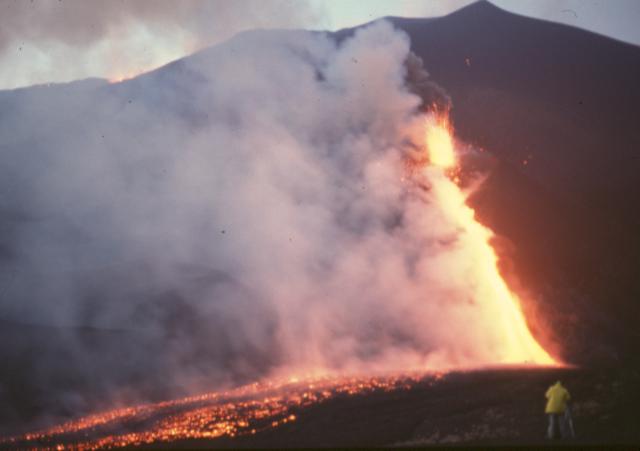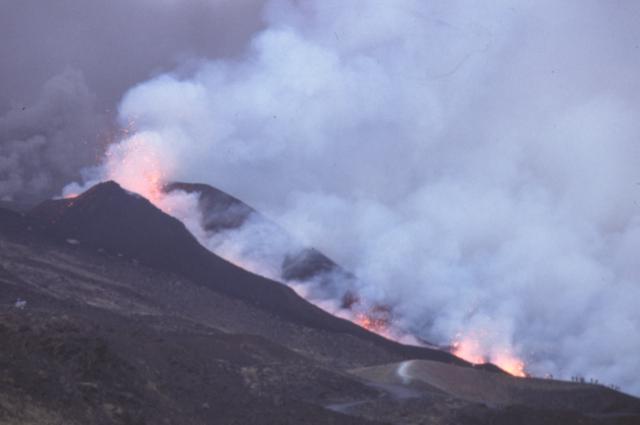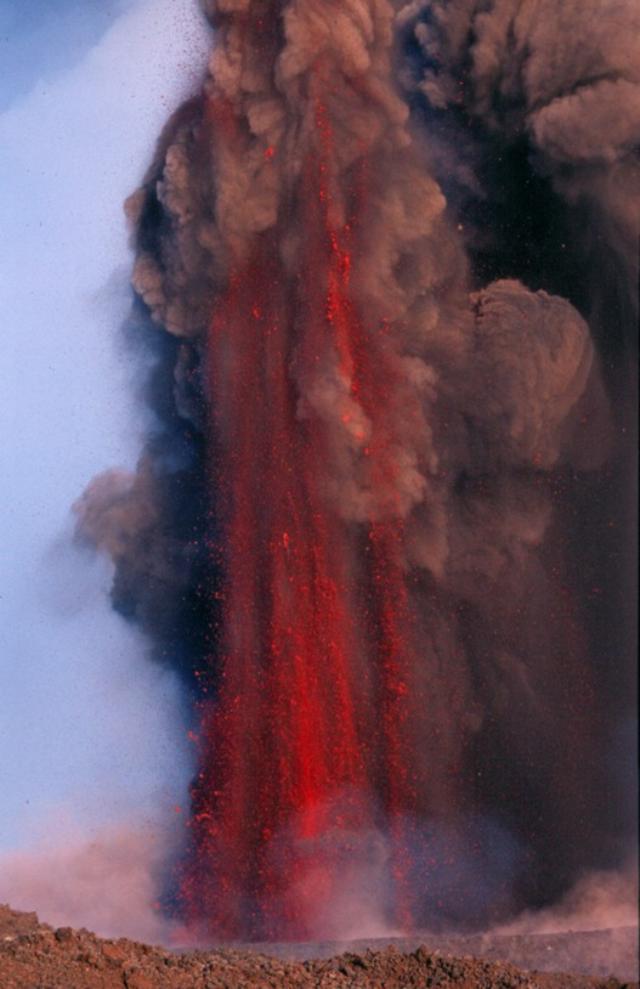Report on Etna (Italy) — September 2001
Bulletin of the Global Volcanism Network, vol. 26, no. 9 (September 2001)
Managing Editor: Richard Wunderman.
Etna (Italy) Strong June eruptions, a M 3.9 earthquake, copious July-August flank lavas, and a new cone
Please cite this report as:
Global Volcanism Program, 2001. Report on Etna (Italy) (Wunderman, R., ed.). Bulletin of the Global Volcanism Network, 26:9. Smithsonian Institution. https://doi.org/10.5479/si.GVP.BGVN200109-211060
Etna
Italy
37.748°N, 14.999°E; summit elev. 3357 m
All times are local (unless otherwise noted)
Although Etna's early June 2001 eruptions were unusually vigorous (BGVN 26:08), still more energetic behavior followed. An earthquake swarm took place in mid-July, and large SSE-flank eruptions vented lavas in late July and early August on a scale not seen since 1983.
This report covers mid-June through early August 2001. During this interval, the highest cited lava fountains reached heights of ~ 0.7 km; ash plumes rose 3 km; lava flows stretched ~ 6 km from their source vents (largely, though not exclusively traveling due S); and people constructed earthen berms to constrain lava flows. Etna repeatedly made international news during this period. Outstanding photographs appeared widely; some may be seen on the website of Tom Pfeiffer, who graciously provided several for this report.
The text of this report came from two key sources: 1) reports by Sistema Poseidon covered the interval from 11 June-8 July; 2) a report by Jean-Claude Tanguy, Roberto Clocchiatti, Santo La Delfa, and Giuseppe Patanè for 17 July-early August. The latter group acknowledged the valuable insights from Giovanni Frazzetta of Sistema Poseidon and from local guides, particularly Alfio Mazzaglia, Antonio and Orazio Nicoloso, Alfio Carbonaro, and Giuseppe Mazzaglia. The group also received valuable contributions from Charles Rivière and Giuseppe Scarpinati.
Activity during 11 June-8 July. In the weeks of middle to late June the N-flank of the secondary vent at Southeast Crater (SEC) was very active. There were four eruptive events there during 11-17 June. Between these episodes volcanism was limited to degassing at all of the summit vents and lava outpourings from the SEC N-flank vent. Lava flows reached a length of just over 2 km, descending to elevations of 2,600 m or lower. Some lava fountains were accompanied by brown ash emissions for periods of 10 minutes to several hours. Each fountaining episode commenced with 5-11 hours of buildup, followed by more intense events lasting ~1 hour. Observers in a helicopter on 17 June saw a widening of the interior of Bocca Nuova (BN), primarily in the W sector extending ~20 m back from the former crater rim.
During 18-24 June SEC's N-flank vent produced three vigorous eruptive episodes. The first episode began about 1700 on 19 June and increased gradually in intensity. At 2040 the lava fountains reached ~ 700 m high; these diminished at about 2110, and after 2130 the episode ended.
A second N-flank SEC episode began at about 1700 on 22 June. At 1730 lava fountaining reached a height of ~ 200 m accompanied by brown ash, possibly indicating that the vent had widened. At about 1750, the lava fountain at the secondary vent produced jets up to 10-20 m and lava spattering from the N base, which ultimately widened the lava field. During this time the lava fountain from SEC increased to 300-400 m high. The associated reddish ash plume rose 1-2 km above SEC. At 1800 on 22 June lava fountaining became almost continuous, but without a continuous ash column. At 1810 the ash plume rose to over 3 km, with the quantity of ash in the plume increasing gradually; lava emissions from the secondary vent increased simultaneously. The event diminished rapidly after 1835.
The third episode began on 24 June with a small lava emission at the base of SEC. Unlike the preceding two episodes, this one began with consistent ash emissions from Northeast Crater (NEC), beginning about 1654 on 24 June with pressurized pulses that formed a plume ~1 km high at about 1700. Ash emissions continued for the next few hours and at 1815 Strombolian eruptions began again at SEC. At 1930 explosive activity began at the secondary vent on the N flank of SEC. At 2000 the explosive activity spread to the whole fissure. Lava emissions increased rapidly, and at 2015 lava fountains reached 200 m high. Lava flows at 2045 reached a length of ~ 2-3 km. The episode peaked at about 2030, diminished visibly at 2115, and had ended completely by about 2250.
SEC generated its tenth eruptive episode of the month on 27 June. The strongest part of that event took place during 2120-2200, with Strombolian activity becoming more intense and lava fountains at the summit reaching 400-500 m high. This event ended about 2300. Another event at SEC took place on 29 June, with flashes coming from the NE flank. At NEC, mixed ash and gas emissions continued. A continuous plume was produced over the summit of the volcano, variable according to the wind intensity and extending for a few hundred meters.
During 2-8 July, explosive Strombolian episodes continued at SEC. The periods between events were calm. An eruptive episode on 4 July began with slow lava emission from the N-flank secondary vent, followed by increased Strombolian activity at the summit. Explosions were discontinuous but violent, with fragments of incandescent magma ejected 150-200 m above the crater rim. The secondary N-flank vent produced less explosive activity. The intensity peaked at about 2100 when lava emerging from the summit vent of SEC reached a height of 50-60 m, and explosions sent ejecta to a height of ~400 m. At this time, a lava flow reached a length of ~2 km to the E, heading toward the Valle del Bove. Beginning at 2150 on 4 July, the Strombolian explosions became progressively less frequent although at that time the lava flow was being vigorously fed.
A few days later, tall ash plumes appeared. Activity began on 6 July with the reactivation of the then slow-moving lava flow emerging from SEC's N-flank secondary vent. At about 0600 copious degassing was seen at the SEC, accompanied by sporadic Strombolian explosions. At 0745 an ash-rich eruptive cloud containing lapilli rose 500-600 m. The plume blew E and SE and continued to ascend to 1.5-2.0 km above the crater area. One of the larger outbursts during the reporting interval, the eruption produced widespread ashfalls in the areas of Milo and Zafferana Etnea to Aci Castello and the northern limits of Catania. At about 1000 the explosions became progressively less frequent and strong. The lava flow continued to be well-fed and reached a maximum length of more than 2.5 km. The lava front reached nearly to the base of the W face of the Valle del Bove, not far from Monti Centenari. From 1050 on, the explosive phase diminished, although the lava flow was well-fed until about 0700 on 7 July.
Early on 13 July the 14th SEC event was accompanied by an impressive earthquake swarm, which included a M 3.9 shock felt to the SE, particularly in the coastal town of Acireale. More than 2,000 shocks were recorded during the following two days. Meanwhile, fissures appeared and gradually enlarged on the upper S flank along the 1989-91 fracture zone, a place where unusual fumarolic activity had previously been observed.
Activity during July-August 2001: S-flank fissures. On 17 July another strong eruption from the SEC was followed by lava venting from a fissure near 3,000 m elevation. This spot lay just below the "Sudestino," a small parasitic vent that had appeared last year at the S base of the SE cone, and where incandescence had persisted at a depth of a few tens of centimeters. Weak explosive activity quickly formed small hornitos, and lava flows proceeded SE towards the Valle del Bove depression. In the afternoon of the same day new vents appeared between 2,800 and 2,700 m elevation, along a trend oriented SSW. These vents emitted lava fragments and moderate lava flows that began to invade the area of the upper cable-way station at 2,500 m elevation.
On 18 July at 0120 another new vent opened to the S at 2,100 m elevation. This vent appeared just beside the Sapienza refuge and the lower cable-way station, ~ 200 m upslope from the famous Mt. Silvestri (cinder cones born in 1892 and subsequently visited by millions of tourists). This vent produced a low lava fountain. A sluggish lava flow gradually grew and traveled W of Mt. Silvestri, threatening a restaurant and cutting the SP 92 road. This became the main lava flow that headed S in the direction of Nicolosi, a village 10 km away at 700 m elevation.
On 19 July at about 1800 an explosive vent appeared near 2,600 m elevation above the Montagnola (a large cinder cone born in 1763, which still dominates the landscape and towers over the Sapienza tourist complex). The Montagnola vent area sometimes contains a small ephemeral crater lake that is variously called "Cono del Lago," "Cratere del Lago," and "Montagnola 2" (M2). M2 is ~3 km S of SEC. On 19 July the M2 vent released dense clouds of fine ash that disturbed people on Etna's E and S sides.
On 20 July the fracture zone extended northward, cutting across and beyond the SEC summit. Where it descended the other side of the mountain, it formed a strange, curved fissure that opened at 2,650 m elevation, forming a vent. The fissure followed the northern base of the Valle del Leone depression. This vent emitted a moderate lava flow and built a small hornito.
The climax of the eruption was reached on 21-23 July when phreatomagmatic activity from the M2 vent fed an impressive and continuous ash plume (figure 86). The plume interrupted air traffic at Catania airport and caused disruptions as far away as Syracuse, 100 km S of Etna. By this time the main lava flow from the 2,100-m vent (figures 87 and 88) had reached 1,030 m elevation, ~ 6 km from its source and 4 km from Nicolosi. However, no concern was raised for the little town as the lava fronts had practically stopped advancing on the gentle slope and the effusion rate remained moderate (5-10 m3/s).
 |
Figure 88. The main lava flow from Etna's 2,100-m vents. Montagnola lies in the background. The photo was taken from Mount Silvestri with the camera pointed N. Courtesy of J.C. Tanguy. |
The Sapienza complex at 1,900 m elevation was more seriously threatened by lava flows. Some of these flows had originated at the 2,700 m vents, and later from effusive vents at the lower base of M2 (near 2,580 m elevation on 26 and 31 July). Earthen barriers protected the buildings; however, the complex was left in a vulnerable hollow between the new lava flows on the E and the 1983 flows on the W.
The highly explosive M2 vent at 2,600 m elevation created a big show beginning with black ash mixed with a few incandescent materials forming jets with the elongate shapes of Cypress trees (figure 89). On 25 July the activity turned magmatic, quickly building a scoria cone ~ 97 m high (based on post-eruption range-finder and altimeter measurements that yielded summit and lower SW base elevations of 2,674 ± 3 m at 2,577 ± 5 m, respectively).
A second climax was reached on 28 July when powerful explosions hurled car-sized lava lumps in a radius of over 500 m. These seriously damaged the upper cable-way station and rattled windows all around the volcano (figure 90).
The eruption's waning stages began 1 August. Ash became more and more abundant from the M2 vent, but was driven by considerably decreased pressure. Effusive activity had practically stopped at the 2,580-m-elevation vents. On 2 August both explosive and effusive activity ceased at the 3,000-m-elevation hornitos, and activity began to decrease along the 2,700-m-elevation fissure, except for the lava flow, which remained well fed and headed SW. At the M2 vent ash emissions practically ceased on 6 August and at the 2,100 m vents the last lava flow was observed on 8 August.
This eruption appeared quite unusual in a number of ways. The flank fissure always remained active throughout its entire length, from 2,100 m to 3,000 m elevation and above (small lava flows were seen several times on the NE side of the SEC at 3,100 m elevation, for example, on 24 August. The explosivity of the M2 vent was exceptionally high for Etna. The lavas emitted in the upper region are almost aphyric, whereas products from the M2 and 2,100 m vents are rich in large phenocrysts, including amphibole, and contain numerous inclusions from the sedimentary basement (sandstones). Although further detailed study is needed, this fact led several scientists to suggest that the 2,600-2,100 m part of the fissure represents a separate eruption triggered by upslope activity.
Geological Summary. Mount Etna, towering above Catania on the island of Sicily, has one of the world's longest documented records of volcanism, dating back to 1500 BCE. Historical lava flows of basaltic composition cover much of the surface of this massive volcano, whose edifice is the highest and most voluminous in Italy. The Mongibello stratovolcano, truncated by several small calderas, was constructed during the late Pleistocene and Holocene over an older shield volcano. The most prominent morphological feature of Etna is the Valle del Bove, a 5 x 10 km caldera open to the east. Two styles of eruptive activity typically occur, sometimes simultaneously. Persistent explosive eruptions, sometimes with minor lava emissions, take place from one or more summit craters. Flank vents, typically with higher effusion rates, are less frequently active and originate from fissures that open progressively downward from near the summit (usually accompanied by Strombolian eruptions at the upper end). Cinder cones are commonly constructed over the vents of lower-flank lava flows. Lava flows extend to the foot of the volcano on all sides and have reached the sea over a broad area on the SE flank.
Information Contacts: Sistema Poseidon, a cooperative project supported by both the Italian and the Sicilian regional governments, and operated by several scientific institutions (URL: http://www.ct.ingv.it/en/chi-siamo/la-sezione.html); Jean-Claude Tanguy, University of Paris 6 and IPGP, 94107 St. Maur des Fossés Cedex, France; Roberto Clocchiatti, CNRS and CEN Saclay, 91191 Gif sur Yvette Cedex, France; Santo La Delfa and Giuseppe Patanè, University of Catania, 55 Corso Italia, 95129 Catania, Italy; Tom Pfeiffer, Department of Earth Sciences, University of Aarhus, C.F. Møllers Allé 120, DK-8000 Aarhus C, Denmark (URL: http://geo.au.dk/).





